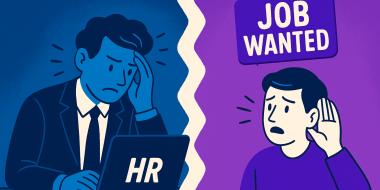How To Make a Creative Resume
While most employers prefer a simple, professional resume, there are some situations where a more creative and unique resume can work to your advantage. This article will cover what a creative resume is, the pros and cons of using one, when a creative resume is appropriate, and a few sample ideas and tips to get you started.

What Is a Creative Resume?
A creative resume generally contains much of the same information as a traditional resume, but it is presented in a more fun or interesting manner. Creative resumes are often tailored to a specific industry in order to show off your relevant skills and set your application apart from others. For example, a graphic designer might make an infographic style resume or otherwise make a visually interesting resume, while a videographer might create a video resume.
Benefits of a Creative Resume
There are a few different benefits of creative resumes. First, they can serve to grab a hiring manager’s attention better than a traditional resume, which can help you stand out from a crowd of applicants.
Additionally, creative resumes can be a more effective way to demonstrate your skills and qualifications, especially if you are applying to a job that relies on visual information such as graphic design, acting, modeling, photography, videography, and so forth. It’s often difficult to translate these skills effectively onto paper, so incorporating samples of your work directly into your resume can be very helpful.
Finally, if you do not have a lot of professional work experience, a creative resume can help you emphasize your skills and other qualifications over your chronological work history (or lack thereof).
Disadvantages of Creative Resumes
However, there are some disadvantages of using a creative resume as well. First, many companies and hiring managers prefer traditional resumes since they are generally easier to read and compare with other applications. Some hiring managers may also feel that including graphics, visual aids, design elements, or other non-traditional resume elements is distracting and unnecessary.
Plus, many companies now use applicant tracking system (ATS) software to screen every resume that they receive. These automated systems search for keywords that the employer has specified in order to determine if the applicant has the desired experience, skills, and so forth. ATS software can only scan text, however, so if your creative resume includes graphics or other non-text elements, it may be automatically rejected by the ATS or not even scanned at all.
Expert Tip
When To Use a Creative Resume
If you are considering using a creative resume, think about whether your creative abilities are sufficient to create a compelling one as well as if it’s appropriate for your industry. For example, if you are applying to a role in a staid industry like finance or law, a creative resume wouldn’t be appropriate and would likely actually hurt your candidacy. In general, if your industry has a dress code, a traditional executive-style resume will be your best bet.
Your creative resume needs to be professional, and it needs to present all of your relevant information.
It can take quite some time to create one, and it needs to be visually appealing as well as effective. If you aren’t completely confident in your ability to make an effective creative resume, you may be better off sticking to a traditional resume.
Creative Resume Example Ideas
If you have decided that a creative resume is appropriate for your industry and you have the skills and abilities to create an effective one, here are a few ideas for creative resume formats to help you get started:
Infographic
An infographic can be a good option for graphic designers, web designers, those who work in IT, and so forth. An infographic will still contain some written text, but it is visually more interesting and can show off your design and presentation skills better than plain text.
Video Resume
A video resume can be useful if you are applying to a visual or performance-based role, such as acting, teaching classes, presenting, and so forth. They can also be suitable if you are applying to work as a videographer or video editor. Video resumes are generally most successful when they are kept between 30 seconds and two minutes in length.
Online Portfolios
An online portfolio can serve as a supplement to a traditional resume or as a resume in its own right if you include your essential information in addition to the past work or visual elements that you are showcasing.
Unique Twist on a Traditional Resume
Finally, you can use a traditional resume as the basis for your creative resume, but add interesting elements like color blocks, textures, unique fonts, and so forth. For instance, if you are an illustrator, you might create an illustrated border or header for your traditional resume. This will make your resume stand out to potential employers but the written portion will still be scannable for the ATS.
Tips for Creating a Successful Creative Resume
Finally, here are some tips to help you make a compelling creative resume:
1. Add Color
While traditional resumes should mostly employ muted colors or no colors at all, a creative resume can have pops of color that help show off your personality as well as your design skills, taste, and style.
2. Use Interesting Fonts
While it’s generally best to use a relatively plain, easy-to-read font for the body text of your resume, you can experiment with more creative fonts for your name at the top of your resume as well as your headings and subheadings. However, be sure that the text is still readable.
3. Use a Design Program
If you really want to create a unique resume, you may need to use a design program rather than a word processor or a template. However, be sure that you know what you are doing in the design program before attempting this so your resume turns out looking polished and professional.
4. Keep It Professional and Relevant
With a creative resume, you still need to present the essential information that would be expected on a traditional resume, such as your name and contact information, work experience, education, skills, and so forth. Additionally, be sure that everything you include on your creative resume is relevant to the position that you are applying for.
5. Make Sure It’s Printable
If you are submitting a resume that involves colors, graphics, and so forth, be sure that the resume can still be printed easily and that everything is still legible when printed. Ensure that your font color contrasts with the background color so that even if your colorful resume is printed out in black and white, the hiring manager will still be able to read it.
Key Takeaways
Creative resumes provide a little more flair and visual interest over traditional written resumes, and they can be beneficial for those who work in creative or visual fields. Demonstrating your skills can be more effective than trying to outline them in writing. When deciding if a creative resume is right for you, consider whether you have the time and abilities to create an effective one and whether it’s appropriate for your industry. If so, be sure to include all of the essential information that would be on a traditional resume. If you are concerned about ATS scans, you may wish to submit a traditional written resume in addition to your creative resume.
Not sure what information to include in your creative resume? Create your traditional resume first with Jobseeker’s professional resume templates. You’ll have an ATS-optimized resume to submit and you’ll learn which information to include in your creative resume.
Impress potential employers with your resume
Follow step-by-step professional guidance to create a polished resume in minutes.



